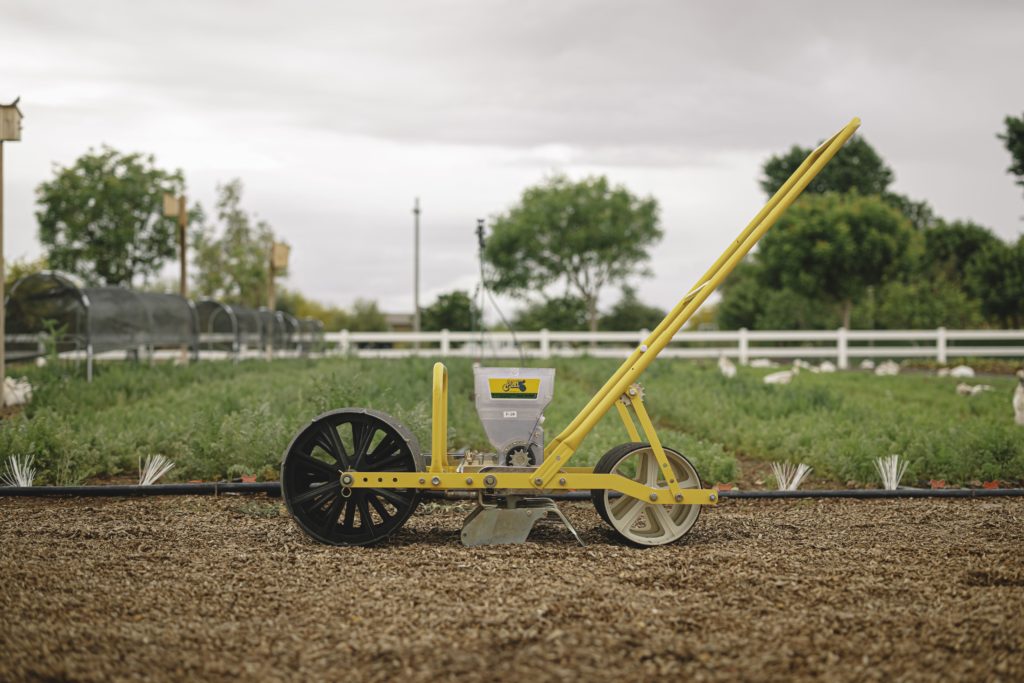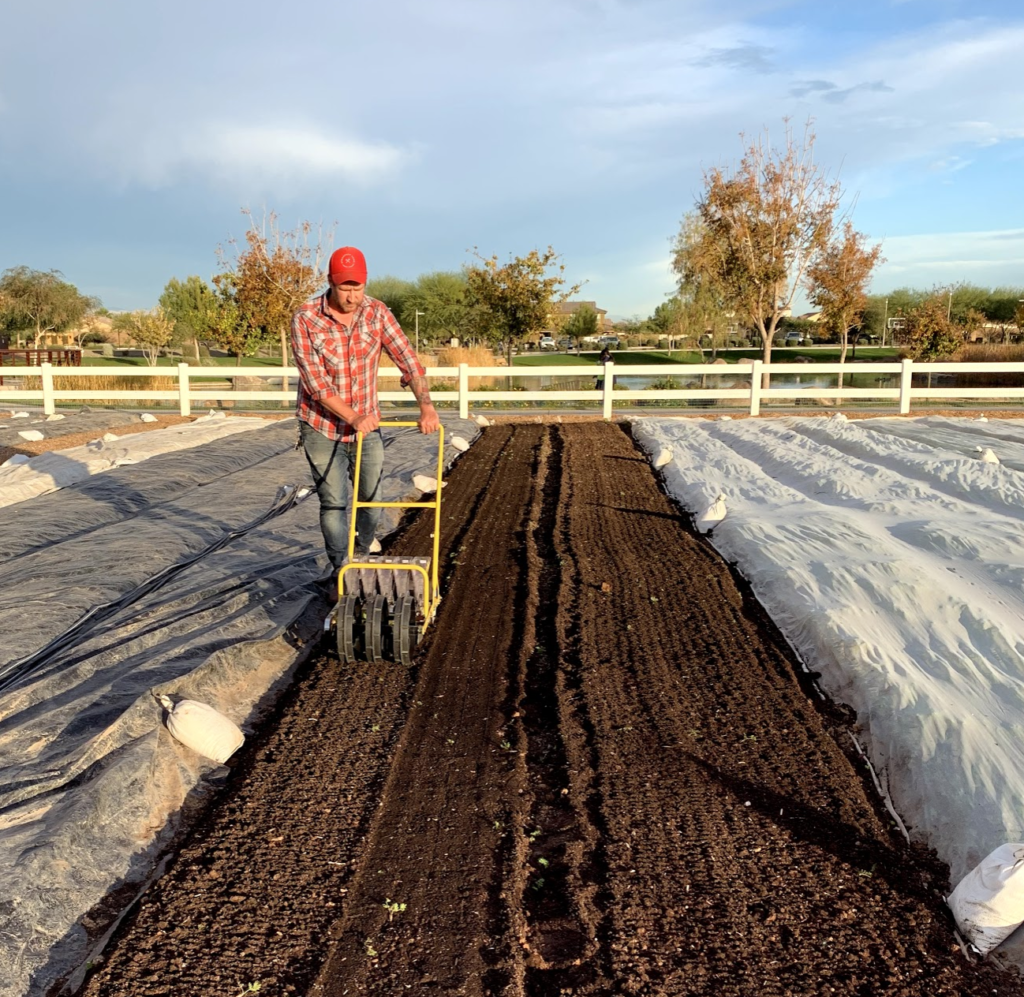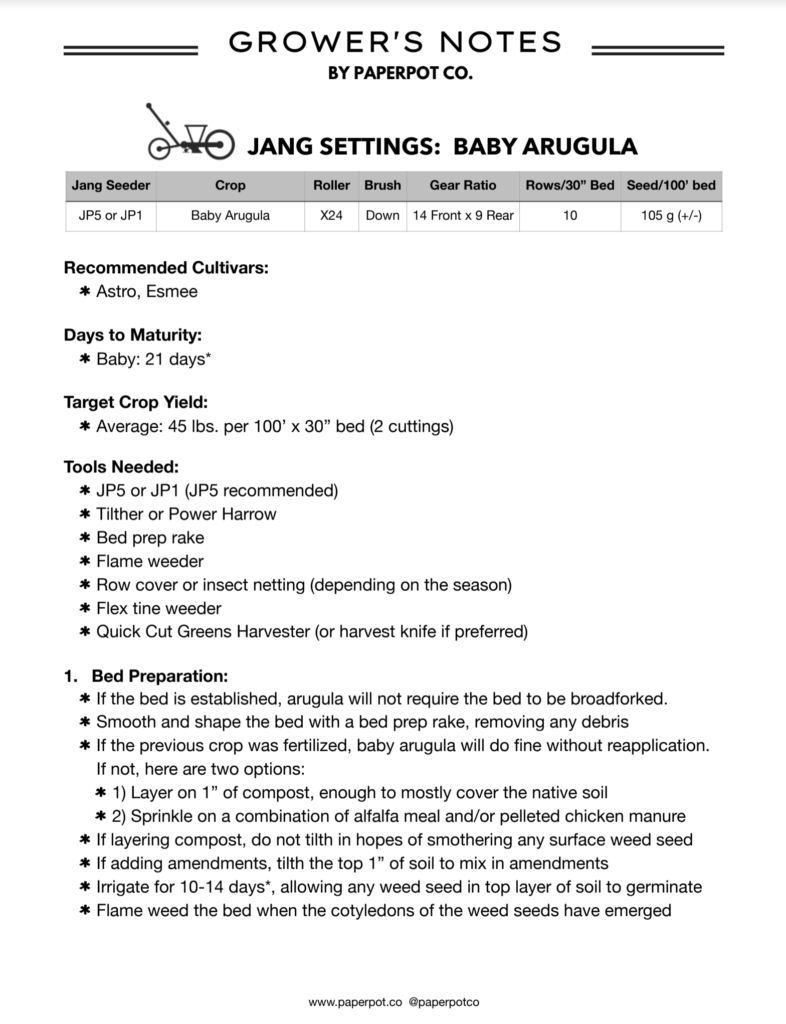How to plant the most common vegetable crops using the Jang JP1 or JP5 seeders?
Figuring out where to start when it comes to direct seeding can be tough.
To make things easier we created the Paperpot Co. Growers Notes to get you successfully started with the Jang JP1 or JP5 farm seeder.
The Growers Notes cover everything you need to get going with a Jang seeder, from recommended plant cultivars to soil preparation to harvesting.
Use the information in these notes as a jumping-off point; you can adjust as needed based on your local conditions.
Download all of the Jang Seeder Growers Notes here.

Jang JP5 Seeder
First Things, First. Why Use a Jang Seeder?
The JP1 is the classic single-row Jang seeder.
It has become an industry standard for market farmers around the world due to its ability to perform well in all soil conditions for a wide variety of crops.
It is extremely accurate and precise allowing you to control seed spacings down to one-half inch.
The many available rollers for the JP1 enable it to plant seeds as small as carrots and arugula or as large as peas and corn.
The JP1 is made in South Korea and its quality is second to none. Its heavy-duty construction will keep going year after year, unlike cheap Chinese knockoffs. If cared for and properly maintained the JP1 will last a lifetime and will likely be the only single-row seeder you ever need to buy.
For farmers looking to save time, Jang created the JP5, which enables you to seed up to five rows of vegetables in a single pass. It’s been an industry gamechanger since it was released a few years ago.

Planting with a five row Jang JP5 seeder.
How Do I Use the Jang Seeder to Plant My Crop?
To answer this question, let’s walk through a sample of the Growers Notes for baby arugula.
At the very top of each set of notes, you will find the basic Jang seeder settings.
These settings apply to both the JP1 and the JP5.
- Jang Seeder: JP1 or JP5
- Roller: X24
- Brush Position: Down
- Gear Ratio: 14 Front x 9 Rear
- Rows per 30″ Bed: 10
- Seed per 100′ Bed: 105g
Next, we cover the recommended cultivars. These are proven varieties that have shown themselves to be productive on multiple farms throughout North America.
Recommended Cultivars: Astro, Esmee
To help with planning we’ve also included the estimated Days to Maturity and Target Crop Yield. This will give you an idea of how large of a harvest to expect and when.
Days to Maturity: Baby: 21 days*
Target Crop Yield: Average: 45 lbs. per 100’ x 30” bed (2 cuttings)
Like any great farm tool, the Jang doesn’t exist in a vacuum; it and requires other tools to work successfully. All of the listed tools help create the best conditions for seeding and for growing the crop after it has been seeded.
Tools Needed:
- JP5 or JP1 (JP5 recommended)
- Tilther or power harrow
- Bed-prep rake
- Flame weeder
- Row cover or insect netting (depending on the season)
- Flex-tine weeder
- Quick Cut Greens Harvester (or harvest knife if preferred)
Now that you know the correct seeder settings and tools that are needed, you can put them to work.
Each Growers Note walks you through all of the steps from bed preparation to washing and packing. Below are the Growers Note instructions for arugula.
Bed Preparation:
If the bed is established, arugula will not require the bed to be broadforked. Smooth and shape the bed with a bed-prep rake, removing any debris If the previous crop was fertilized, baby arugula will do fine without reapplication. If not, here are two options:
1) Layer on 1” of compost, enough to mostly cover the native soil
2) Sprinkle on a combination of alfalfa meal and/or pelleted chicken manure If layering compost, do not tilth in hopes of smothering any surface weed seed If adding amendments, tilth the top 1” of soil to mix in amendments Irrigate for 10-14 days*, allowing any weed seed in the top layer of soil to germinate Flame weed the bed when the cotyledons of the weed seeds have emerged
Seeding with the Jang:
Set up the Jang seeder: X24 roller, gears 14 front and 9 rear, brush down. For the JP1, roll out each of the 10 rows evenly spaced across the bed. For the JP5, the bed can be seeded in two passes with 10 perfectly spaced rows.
Irrigation:
Water the beds with overhead irrigation. This will chase away any pre-existing flea beetles on the soil.
After the first watering, IMMEDIATELY cover the beds with floating row cover (or insect netting in the warm season). The cover will only come off for cultivation and harvest times. Weigh down the edges with sandbags every 5 feet. This ensures flea beetles will never have a chance to damage the greens.
For all subsequent irrigation, water directly over top of the row cover or insect netting, which rests directly on the crop
Frequent, shallow waterings will support rapid growth and better flavor. It is important to water throughout hot days during the warm season.
Cultivation:
10 days after direct seeding, cultivate using a flex-tine weeder (2 passes per bed). Repeat this process again after another 5 days.
Make sure to return row cover immediately after cultivation to keep away pests.
Harvest:
The target size for harvest is a 3-5” leaf with no more than 1” of the stem. Approximately 21 days to harvest (depending on the season)
The JP5 seeder works well with the Quick Cut Greens Harvester. One pass along each side of the bed effectively cuts 5 rows of greens at a time.
Keep the blades sharp, and make sure the harvester stays out of the dirt. Gently rake the bed clean after the first cutting to ensure a cleaner second cutting.
Washing and Packing:
Arugula is a sensitive green. Wash only one basket at a time to avoid bruising. Agitate the greens by hand (or use a bubbler) for no more than 4 minutes in the wash tube, while scanning for debris, bugs, or damaged greens.
After drying and bagging (usually in 1/2lb or 1lb bags), store the arugula in a refrigerated space.
Attempt to sell arugula within 3 days of harvest for the highest quality.
* All dates can vary based on local climate and soil conditions and time of year.
SAMPLE JANG GROWERS NOTES
DOWNLOAD ALL OF THE JANG GROWERS NOTES
The Growers Notes were developed in partnership with farmers Erich Schultz of Steadfast Farm and Seth Davis.
We hope that these Growers Notes will be a great starting point for market gardeners.
While we tried to standardize the procedure as much as possible, it may be necessary to change steps or timing based on local conditions.
If you have any questions, please reach out to us at hello@paperpot.co or 877.850.1555.

